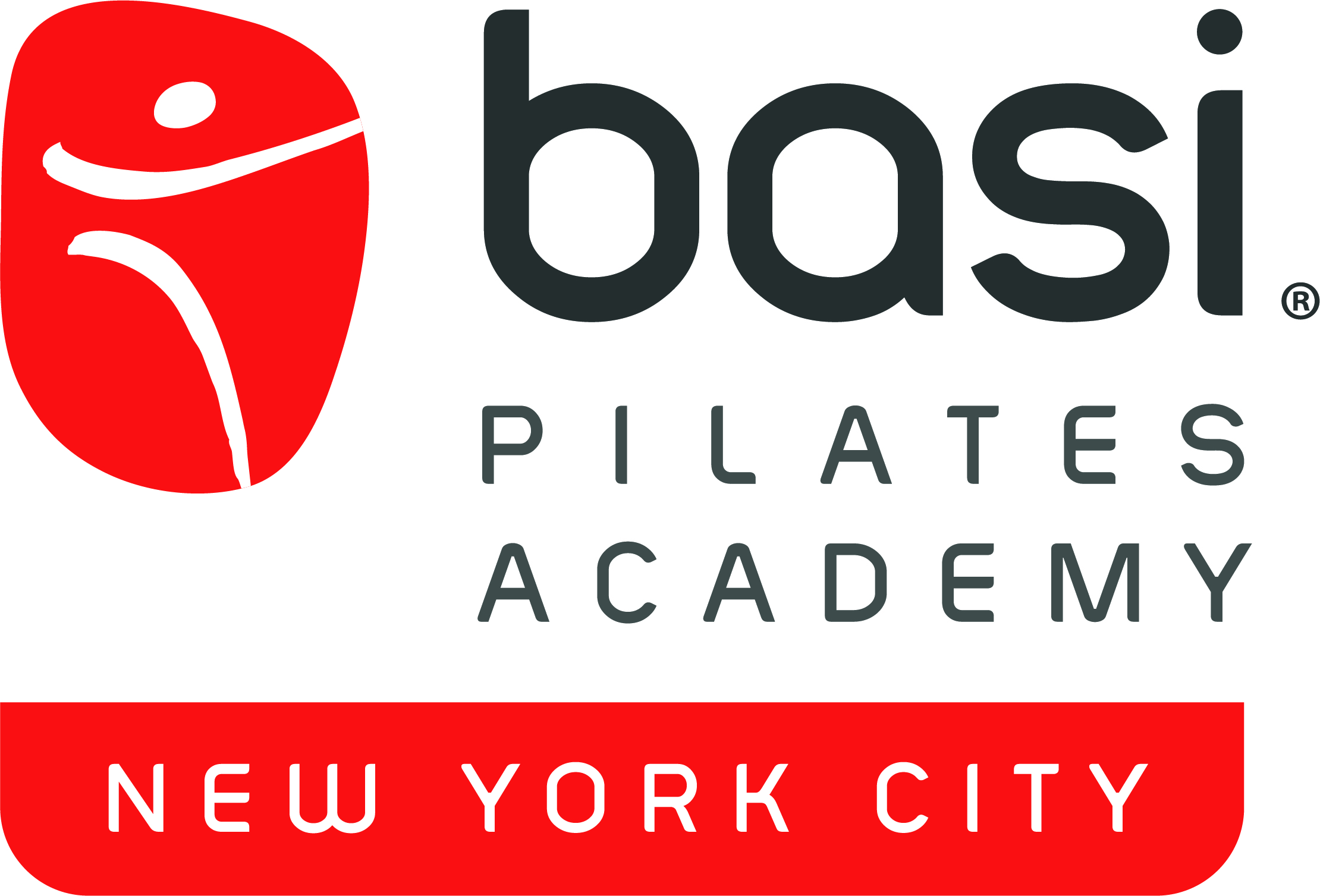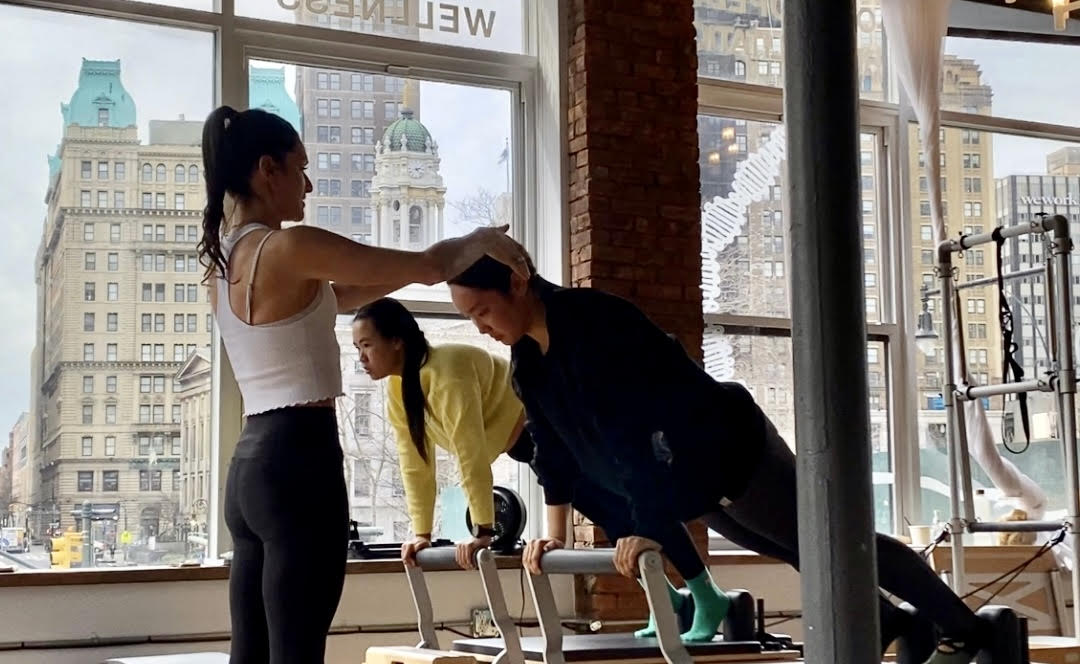Me to my students in mat class during back support: “That is really hard work huh?”
My students: out of breath, eye brows raised, collapsing to the mat -“Yes”
Me: “Yes it is supposed to be hard. I still think it’s hard-so I have a lot of empathy for how you feel right now, but not sympathy….”
Being a Pilates Teacher is cyclical. You learn, study, question, retain, practice, read, watch, practice again, feel…repeat….pass this all onto your students and the process repeats itself all over again. As you observe your students body in motion new information is taken back to the equation as you break down movement patterns. Every time I teach the BASI Pilates Teacher Training Course, or even a regular session, it is a complete expression of myself as a student. It is never solely the expression of what I read, watched or was told. It is always from what I feel during my own practice and what I know through the experience of constant use of reason and logic to determine outcomes in movement arts & science.
The secret to successfully completing a Pilates Teacher Training program is simply in the process. Even more than the outcome of this process, or how “perfect” you can do each exercise, is how we perceive and approach our very unique process. Often a student who has to fight for more ease in an exercise is the one who actually gets the benefits and will teach that exercise more clearly than someone who can easily or passively execute the given movements on day one. The benefits of every theoretical and physical principle is truly in your efforts and your attitude. I know I may sound cliche, so keep reading for some actual examples of this in the Pilates repertoire.
I am still riding high, and a little exhausted:) from the final weekend of the BASI Pilates foundation program with 17 amazing students. Teaching this course is unquestionably my favorite part of my job. This past weekend brought 17 different stories, reasons, capabilities, technical abilities, and 17 different levels of patience all coming together to learn a codified system of exercises on the mat and Pilates apparatus.
More than the textbooks, slides and even my expertise from 20+ years of teaching, was how much each unique story in the room can reflect the work in a different way. A restriction might have us modifying the exercise, but always reiterating the “why.” Making informed choices along with the structure we are given allows for so much freedom as a teacher and as a student. It keeps us on track to understand the clear version of the exercise you need to know for your test out and while we can be quick to modify, we often find this unnecessary when approaching the exercises in the right way. Finding all the strength building qualities in the efforts, and grunting. It is a HUGE misconception of the work that it should be a stretch or that it should not be hard. Don’t misinterpret a professionals ability to make something appear “easy.” This is the act of many years of hard work, lots of breath and continuity in their movement which breed the efficiency of movement that is so enviable. Reminder again that there is no Pilates competition, never has been and never will be. It is the only codified movement system in the world without competition. It is a modality in itself meant to help and nurture all other sports and movement arts.
Every time I teach this comprehensive course I am humbled and surprised by how much it continues to personally challenge and supports the physical demands that I put on my body. I am able to feel advances in my own body each year and as I demonstrate some of my less favorable moves and I am reminded of the ones I need the most. The constant interaction in by brain as a teacher and student is as intertwined as ever. I do always feel insanely strong after a solid weekend teaching pure matwork and detailed apparatus repertoire each day. I often joke, “It works!” To my husband every night when I get home.
In the first part of the course we learn the 36 mat exercises alongside progressive beginner and intermediate apparatus repertoire. The matwork is like a barometer for our strength, ROM, breath, and coordination. The ease or lack of ease in each exercise will reveal something to celebrate, or something to give more attention to in our exercise programming.
I am now very proud that not a single mat exercise ever came easy to me. I was naturally on the strong side, but I have to work for every tiny bit of range I have in my spine, hips, and shoulders. Roll-up felt impossible for me to articulate my spine, rolling over felt like so much compression on my neck, my hips clicked during leg circles, I always could plank for hours but was very much in my neck and shoulders, side lying bothered my bony hips, and my back extension was so small if I didn’t crush my lower back trying to make my movements bigger.
Twenty five years later practicing this work, I have not simply overcome all that I mentioned above. My body has changed a lot, my muscles have more range and I move more efficiently, but these issues did just go away over time, I worked appropriately to alleviate where I was having trouble and was patience with my progress, tapping into how I really feel after I train with many ups and downs. I most certainly still do not think anything is ‘easy.” I remember all the trial and error, along with all the details it took for me to achieve really feeling good in my technique and I pass these ideas onto you as teachers to be and forever students of movement.
I always tell my students trying to retain so much information- It is not the shape you create- it is the lines you are drawing. Don’t try to make your picture look like anyone else, even if you are following the same directions. The set up and alignment of each exercise is so important, but remember that ideal alignment is home base for your posture. This should be understood and studied, but not be forced. It is a guide on how to direct the body in stability and mobility. For example, ideal alignment of the head and neck should be ears over shoulders, or forehead over sternum. When correcting someones posture of their head, it should first be considered if their muscles and joints can achieve such alignment. The process here might be simple reminders and repetition. It might also be the need for manual work, or the baby steps of learning how to turn off over active muscles and recruit the weaker ones. Almost always, it requires the need to involve the upper back and shoulders along with the relationship to the pelvis. The benefits will be in these efforts rather than skipping the steps and trying to force the body to do something it isn’t ready for.
Below I am reviewing common challenges for students and teachers in training including the Roll Up, Leg Circles, Front Support, and Swan along with apparatus repertoire that correlates with resistance and assistance.
Next month I will further discuss the common difficulties and benefits of the efforts in the following exercises along with their correlating apparatus exercises for: Roll Over, Leg Pull Front, Back Support and Side Bend.
In the mean time, practice the process, process your practice, and seek precision over perfection 🙂
Visit my instagram @lyndalogic for variations and modifications on these exercises. Visit our studio page @bpa_nycity for more insights and full length videos on our donation based virtual studio that grants scholarships for in person work at our facilities virtualogic.earth.
ROLL UPS
Common difficulties are:
- The legs want to lift up as we roll the spine off the mat
- Articulation is challenging and momentum rather than strength is used to get up.
The benefits are in the efforts of:
- Engaging and pressing down into the back of the legs (hip extensor muscles) to stay anchored as you roll up.
- Connecting into the adductor muscles of the hips and shoulders
- Using breath and focus to articulate the abdominals will gain access to more mobility in the spine and build functional strength in the trunk.
LEG CIRCLES
Common difficulties are:
- Keeping the bottom leg and pelvis stable.
- Popping or crunching in the hip flexor as the leg circles.
- Keeping the top leg straight.
The benefits are in the efforts of:
- Putting most of the effort into pressing the standing leg down into the mat.
- Making the leg circles only as big as you can maintain stability of the pelvis against this movement.
- Using the quadricep muscle to straighten the circling leg and lengthening the leg within itself rather than trying to bring it closer to your face.
FRONT SUPPORT
Common difficulties are:
- Shoulder and neck tension
- Wrist discomfort
- Lower back instability
Benefits are in the efforts of:
- Engaging shoulder abductor muscles, specifically serratus anterior to alleviate unwanted neck tension
- Engaging the pec muscles along with energetically connecting the hands into and out of the ground.
- Engaging the hip and abdominals to align the pelvis in neutral, often biasing toward a posterior tilt.
SWAN
Common difficulties are:
- Lifting too high and misusing the lower back extensors
- Coordinating the breath with the articulation off the mat
Benefits are in the efforts of:
- Engaging the hip extensors and abdominals to dynamically stabilize the pelvis, especially in the initial phase of the exercise.
- Being satisfied with a smaller stronger shape that utilizes thoracic extensor muscles more than lumbar extensors.

